
17 minute read
The Miami Project To Cure Paralysis Faculty
The faculty of The Miami Project are a talented multidisciplinary team. In the following Profiles, each faculty member describes their specific research focus and highlights of recent progress.
W. DALTON DIETRICH, PH.D. Scientific Director
Kinetic Concepts Distinguished Chair in Neurosurgery
Senior Associate Dean for Discovery Science
Professor, Departments of Neurological Surgery, Neurology, and Cell Biology
Neuroprotection and Improved Recovery of Function following CNS Trauma
My research interest is the pathobiology and treatment of CNS injury in both the acute and chronic setting. Animal models of spinal cord injury, traumatic brain injury, and stroke are utilized to investigate the cellular and molecular mechanisms of tissue injury. The ultimate goal is to target secondary injury processes for various interventions that may protect vulnerable cell types or promote reparative processes to enhance neuroprotection, circuit plasticity, and recovery of function. The use of therapeutic hypothermia and targeted temperature management in preclinical and clinical settings is currently a focus of discovery and clinical investigations in the laboratory.
BARTH A. GREEN, M.D., F.A.C.S. Professor of Neurological Surgery, Neurology, Orthopedics, and Rehabilitation
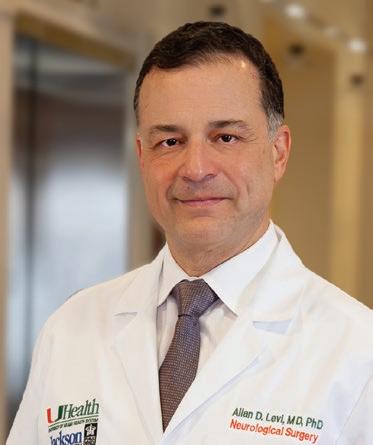
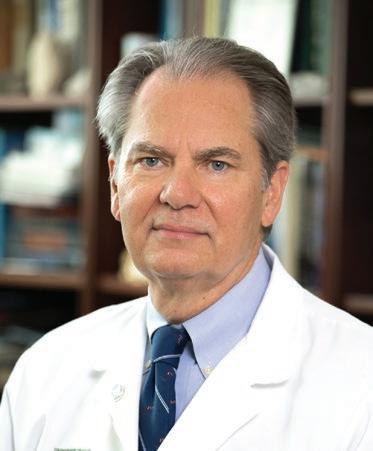
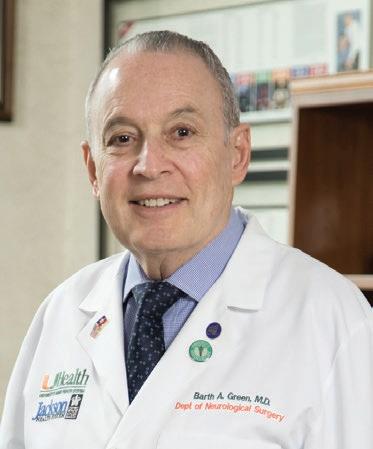
Co-Founder and Chairman, The Miami Project to Cure Paralysis
Executive Dean for Global Health and Community Service
Translational Interventions
Over the recent years my research efforts have mainly involved taking the cutting edge basic neuroscience work product and data created by our Miami Project team from the bench to our UM affiliated clinics and hospitals. A good example of such translational research efforts has included the use of modest hypothermia for neuroprotection both in cases of acute spinal cord injury and for use in the operating room for patients undergoing high risk spinal cord surgery. I am also privileged to be able to collaborate with The Miami Project cellular transplantation programs and have been working on projects involving adult mesenchymal stem cells, as well as being part of the major effort transforming our successful Schwann cell laboratory model into clinical trials. Other areas of research and clinical interest include the diagnosis and treatment of tethered cord syndrome, spinal cord cysts and Chiari I malformation.
SCIENTIFIC FACULTY MEMBERS:
ALLAN D. LEVI, M.D., PH.D., F.A.C.S.
Robert. Buck Distinguished Chair in Neurological Surgery
Professor, Departments of Neurological Surgery, Orthopedics, and Physical Medicine & Rehabilitation
Chairman, Department of Neurological Surgery
Chief of Neurosurgery, Jackson Memorial Hospital
Cellular Transplantation Strategies after SCI/Systemic Hypothermia after Acute SCI
My clinical research interests currently focus on developing cellular transplantation strategies to repair injuries within both the human central and peripheral nervous system. I am currently Co-PI on our clinical trials involving the transplantation of autologous human Schwann cells (SCs), which represent first-in-man studies of autologous human SCs for patients with sub-acute and chronic SCI. We are also conducting a phase I trial evaluating SCs for peripheral nerve injuries with long segmental defects, which follows up on our previous two single patient experiences. Hypothermia continues to show promise in a variety of acute central nervous system injuries. There are various factors that need to be considered with systemic cooling of the SCI patient, including methods of cooling, window from injury to initiation, duration and depth of hypothermia, rate of re-warming, etc. While profound levels of hypothermia (<32°C) can be difficult to administer and are subject to increased complication rates, mild (modest) levels of hypothermia (32-34°C) have been shown to provide significant protection against traumatic and ischemic neuronal cell death. I am currently the PI of our institutional protocol as well as a multi-center Department of Defense funded randomized trial studying systemic hypothermia induced via an intravascular catheter and continued for 48 hours after acute cervical SCI.
HASSAN AL-ALI, PH.D.
Research Assistant Professor, Department of Neurological Surgery Drug Discovery for CNS Repair
As a chemical and computational biologist, my lab focuses on identifying pharmacological targets that can induce robust axon regeneration in the injured central nervous system. To accomplish this, my lab developed a unique drug discovery platform that combines phenotypic screening, target-based profiling, and sophisticated machine learning algorithms. The approach identified a promising drug candidate that is now in preclinical development. We continue to develop these methodologies to advance drug discovery in spinal cord injury, as well as in other therapeutic areas including cancer and kidney disease.
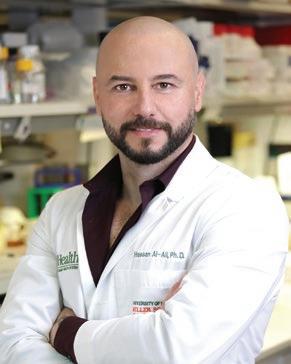
COLEEN ATKINS, PH.D.
Associate Professor, Department of Neurological Surgery
Developing Novel Therapies for Traumatic Brain Injury and Spinal Cord Injury
The research in my laboratory focuses on developing novel therapeutic interventions for traumatic brain injury (TBI) and spinal cord injury (SCI). The research goal of my laboratory is to enhance rehabilitation and recovery by manipulating synaptic plasticity at specific levels of the neuroaxis following TBI and SCI. We have found that specific synaptic plasticity signaling pathways are altered after TBI, and we are currently using pharmacotherapies to target those pathways to improve behavioral recovery after TBI.
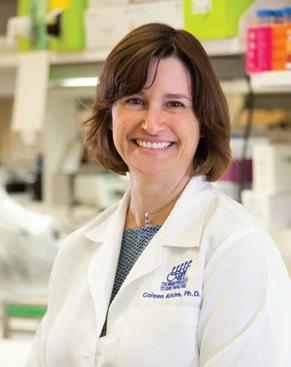
JOHN BIXBY, PH.D.
Professor, Departments of Molecular & Cellular Pharmacology and Neurological Surgery, Center for Computational Science, Hussmann Institute for Human Genomics, Sylvester Cancer Center Vice Provost for Research
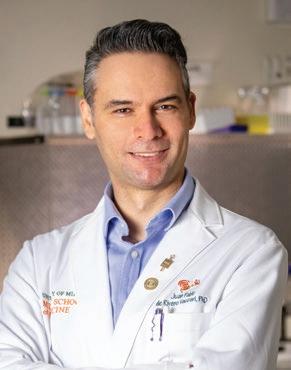
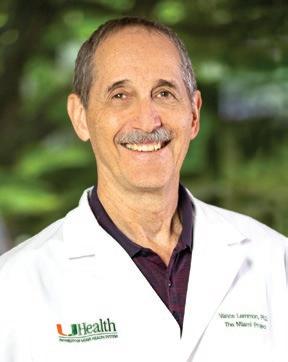
VANCE LEMMON, PH.D.
Walter G. Ross Distinguished Chair in Developmental Neuroscience Professor, Department of Neurological Surgery, Center for Computational Science, Hussmann Institute for Human Genomics, Sylvester Cancer Center
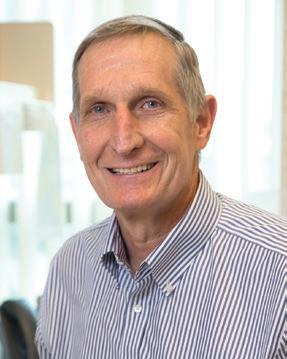
High Content Screening and Functional Genomics of the Nervous System
Our laboratory has developed methods to test thousands of genes or chemicals in hundreds of thousands of neurons each week to obtain quantitative information about cell morphology and gene expression. This “high throughput” capability allows us to tackle questions about axon growth and regeneration using systems biology approaches, and to query the results in animal models of injury. The Lemmon-Bixby lab has several ongoing projects related to axon regeneration. One project is to test the roles of known signaling proteins called protein kinases. In this screen we have tested >1600 kinase inhibitors, dozens of which strongly promote neurite growth in vitro. Using bioinformatics, biochemistry, and machine learning we can identify key kinases and their signaling networks as well as potential lead therapeutic compounds, one of which has proven active in two different models of spinal cord injury. A second project is based on the observation that injured peripheral sensory neurons initiate a genetic program appropriate for axonal regeneration. Our laboratory has combined next-generation sequencing with cell-based phenotypic screening to identify genes, especially transcription factors, that appear to mediate this genetic program, and is testing them in vitro and in vivo. The last project is to test several hit compounds identified in a screen testing 440 million different small molecules to see if the hits promote axon regeneration.
ROBERTA BRAMBILLA, PH.D.
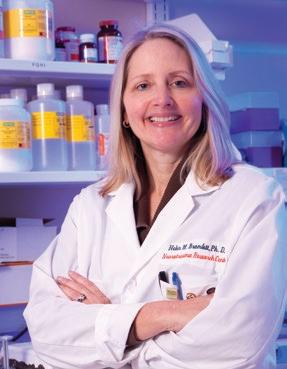
Associate Professor, Department of Neurological Surgery Modulation of the Neuro-Immune Response in Neurologic Disease

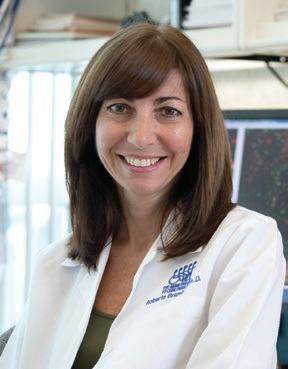
The main focus of my research is to understand the role of neuroinflammation in the pathophysiology of neurodegenerative disorders (e.g., multiple sclerosis, spinal cord injury and stroke), with a specific interest in the contribution of glial cells. We study astrocytes and microglia for their involvement in the neuro-inflammatory response to injury, and oligodendrocytes and oligodendrocyte precursor cells for their role in axon myelination, metabolic support of neurons and myelin repair. Currently, our primary lines of research in the area of neuroimmunology are centered on: (1) investigating the role of tumor necrosis factor and its receptors in the processes of neuroinflammation, demyelination and remyelination, and (2) understanding how mitochondrial dysfunction in oligodendrocytes may be involved in the etiopathology of multiple sclerosis.
HELEN M. BRAMLETT, PH.D.
Professor, Departments of Neurological Surgery and Psychology, Undergraduate Neuroscience
Program Director, and Health Scientist Veterans Affairs
The Pathophysiology and Treatment of CNS Injury
The focus of my neurotrauma laboratory is to investigate both acute and long-term consequences of brain and spinal cord trauma. My current research interests are on the pathophysiology of traumatic brain and spinal cord injury with an emphasis on the pathogenesis of progressive white matter damage as well as the benefits of therapeutic hypothermia. My laboratory is also investigating mechanistic events leading to the development of posttraumatic epilepsy. Additionally, our current work is also focusing on complex traumatic brain injury models that mimic polytrauma as this type of injury has become more prevalent in combat areas.
JUAN PABLO DE RIVERO VACCARI, PH.D.
Research Assistant Professor, Department of Neurological Surgery
Underlying Mechanisms of the Immune Response and Contributions to Various CNS Diseases
My research focuses on understanding early inflammatory events in central nervous system (CNS) injury and disease, as well as aging. Currently, my laboratory studies how natural-aging produces inflammation in the brain, a phenomenon known as brain inflammaging, which potentially precedes the onset of age-related neurodegenerative diseases. In addition, we are studying the mechanism by which brain injury causes systemic inflammation such as acute lung injury. Moreover, we also study the prognostic and diagnostic potential of inflammasome proteins as biomarkers of CNS injury and disease, including brain and spinal cord injury, stroke, multiple sclerosis, mild cognitive impairment and depression.
COURTNEY M. DUMONT, PH.D.
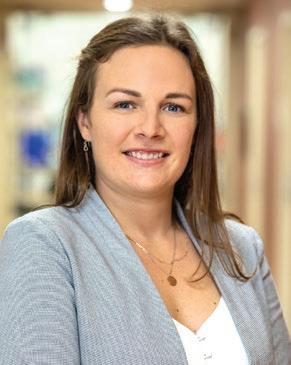
Assistant Professor, Department of Biomedical Engineering
We are currently exploring the integration of nanoscale biomaterials with our scaffolds to improve on-demand pharmacological agent localization within the injury site as well as cytokine scavenging capabilities to reduce inflammation. Together, these strategies will help to move the field of neural tissue engineering forward, while also providing essential information about the underlying cellular biology and injury pathophysiology.
PATRICK D. GANZER, PH.D.
Neural Engineering, Brain-Computer Interfaces, Bioelectronic Medicines and Machine Learning
Broadly we are focused on the role that bioelectronic medicines will play in the understanding and treatment of neurological conditions, with a special focus placed on the importance of timing of stimulation with biologically relevant events. I come to The Miami Project from a background of research focused on enhancing neuroplasticity after sensorimotor injury using targeted vagus nerve stimulation, notably as a Principal for Battelle Memorial Institute’s Bioelectronic Medicine program and the N3 program funded by DARPA. I carry on my work with vagus nerve stimulation, and expand my lab via The Miami Project to understand and steer the somatic and autonomic nervous system after spinal cord injury (SCI).
MOUSUMI GHOSH, PH.D.
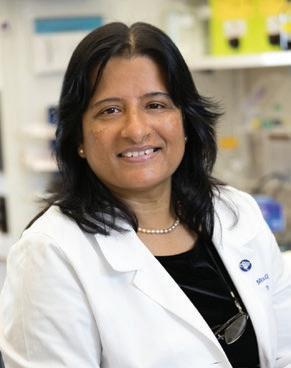
Research Assistant Professor, Department of Neurological Surgery
Altering Host Glial Responses following CNS Injury and Disease to Promote Repair
My research interests are focused on altering the hostile environment of the injured or diseased CNS to one that is conducive to repair through altering inflammation. Specifically, our work focuses on delineating the intrinsic and extrinsic signals present after injury that antagonize the conversion of activated microglia and macrophages to a reparative phenotype in experimental models of CNS injury and disease. We are also interested in understanding how altering the immunophenotypical profile of macrophages and microglia can modulate spinal cord injury induced central neuropathic pain, affect host glial responses, including glial scar formation, as well as influence the ability of transplanted cells, such as Schwann cells and stem cells, to mediate neurorepair.
JAMES D. GUEST, M.D., PH.D., F.A.C.S. Clinical Professor, Department of Neurological Surgery
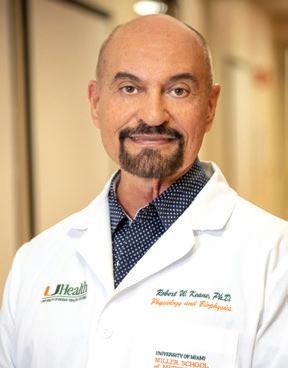
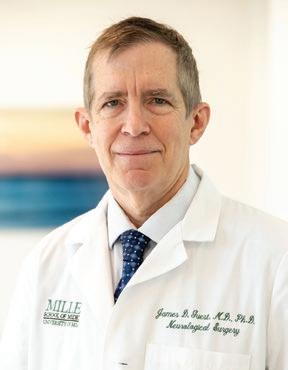
The Preclinical to Clinical Spectrum in Spinal Cord Injury Therapeutics. The Path to Clinical Testing and Establishing Clinical Evidence
Our SCI research spans preclinical proof-of-concept studies of therapeutics into early Phase, and pivotal clinical trials of SCI. We are translational scientists using a variety of clinicallyrelevant tools within the complex process of determining which potential human therapeutics have a probability of success in clinical trial testing. We use our experience and expertise to test combinations of cellular, molecular, tissue engineering and neuromodulatory therapeutics in large animal models. We have expertise in tissue physiologic monitoring, neurophysiology and kinematic analysis of gait. In addition, we have experience in device development and testing. The lab group has members and colleagues ranging from senior medical faculty to postdoctoral students, medical students, neurosurgery residents, and undergraduate students. This is a good setting for those trainees who aim for careers in neurologic therapeutics both in academia and industry and with an interest in how medical evidence is developed. We are simultaneously involved with animal and human studies across the translational spectrum including Phase 1-3 studies.
GILLIAN A. HOTZ, PH.D. Research Professor, Department of Neurological Surgery Director, KiDZ Neuroscience Center; Director, Concussion, WalkSafeTM & BikeSafeTM Programs
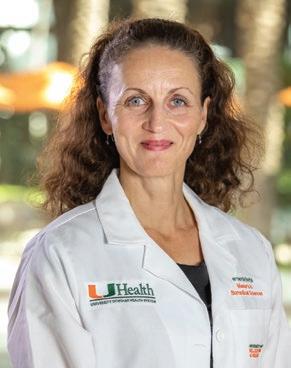
As a behavioral neuroscientist my clinical interests have always been investigating the neurocognitive deficits of those individuals that have sustained a traumatic and acquired brain injury. I have co-authored two neurocognitive tests, The Brief Test of Head Injury for adults and the Pediatric Test of Brain Injury for children. My research has focused on developing evidence based injury prevention programs in order to prevent brain and spinal cord injuries in children. In 2003, our team developed the WalkSafe program, which has been shown to decrease the number of elementary school age children that get hit by cars, and in 2009 we developed the BikeSafe program which educated middle school age children on bicycle safety skills. As the Director of the Concussion Program, we have spent many years developing and implementing a comprehensive countywide high school sports concussion care program, which includes neurologic evaluation, neuroimaging, neuropharmacological management, neuropsychological testing, and baseline test with ImPACT, a computerized neurocognitive screening measure. We also have developed a Concussion Injury Surveillance system. Our program is multidisciplinary and assesses and treats athletes from all levels of play. I am also the PI on many local and federal grants: Safe Routes to School initiatives, Transportation Alternative Programs, GE/NFL MRI Phase 2 study, Brainscope EEG study, one of the TRACK TBI sites, and a new project that will study the Effects of Cannabinoids on Mild TBI.
JONATHAN R. JAGID, M.D.
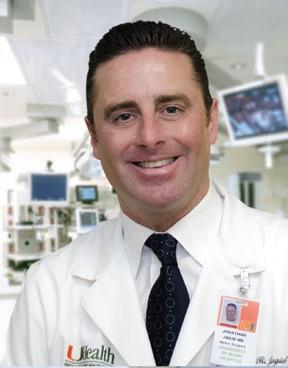
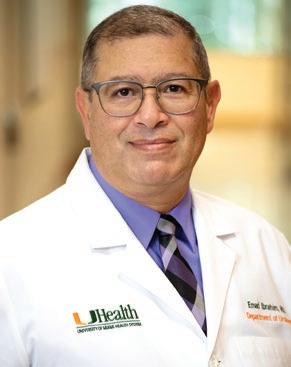
Clinical Associate Professor, Department of Neurological Surgery, Neurology,
Rehabilitation Medicine
Interventions in SCI and TBI
Orthopedics,
My research includes projects investigating the use of Deep Brain Stimulation for spinal cord injury, novel brain machine interfaces to improve quality of life in spinal cord injury, as well as hypothermia for traumatic brain injury. Presently, we are looking at the use of a novel Deep Bain Stimulation device modified to act as a brain machine interface in an effort to bypass spinal cord injury and restore cortically controlled limb movement.
STANISLAVA JERGOVA, PH. D.
Research Assistant Professor
Our lab’s research goals involve investigating potential cell and gene therapies for chronic pain induced by spinal cord injuries (SCI) and other injuries of the central nervous system. We aim to better understand the mechanisms of chronic pain and develop new treatment options that can provide long-lasting relief for patients. As chronic pain is a multifactorial condition with several pathways involved, simultaneous targeting of different pathways with precise localization is essential. Recombinant cells and designed analgesic genes provide a great tool to achieve our goal. We explore different biomaterials as delivery vehicles to develop safe and potent approach to combat chronic pain.
ROBERT W. KEANE, PH.D.
Professor, Departments of Physiology & Biophysics, Neurological Surgery, and Microbiology and Immunology
Regulation of Innate Immunity after CNS Trauma
Innate immunity is the first line of defense against pathogens and host-derived signals of cellular stress. My research focuses on investigating mechanisms that direct normal innate immunity and its dysregulation in central nervous system injury and disease, including (1) agonists and activation mechanisms of inflammasomes, (2) regulatory mechanisms that potentiate or limit inflammasome activation after injury, and (3) emerging data linking inflammasome proteins as biomarkers for CNS injury.
NADINE A. KERR, PH.D.
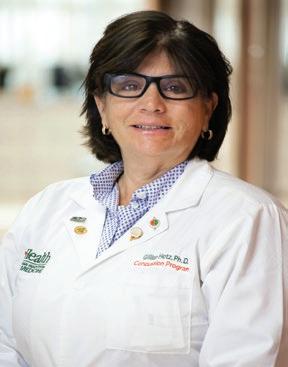
Assistant Professor, Department of Neurological Surgery
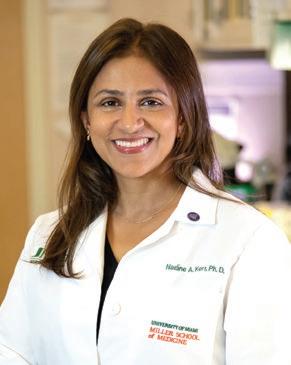
The research is focused on understanding and improving the impairments to male fertility which occur following spinal cord injury (SCI). Following SCI, most men, but not women, experience impaired fertility. Specifically, most men with SCI are anejaculatory, and some experience erectile dysfunction. Although their semen may be obtained by medically-assisted ejaculation procedures, in most cases, semen quality is impaired, specifically, sperm motility and viability are abnormally low, although sperm numbers tend to be normal.
The focus of our research is to examine the pathomechanisms of the systemic inflammatory response and non-neurological organ dysfunction following Central Nervous System (CNS) injury, particularly traumatic brain injury (TBI) and stroke. After CNS injury and damage to the blood-brain barrier (BBB), inflammatory mediators are released into the circulation and contribute to systemic organ damage. This can then lead to further neurological damage resulting in bidirectional communication between the brain and systemic organs. The two main organ systems that we are currently investigating are the respiratory and gastrointestinal systems.
JAE K. LEE, PH.D.
Associate Professor, Department of Neurological Surgery
Promoting Proper CNS Wound Healing Response to Enhance Regeneration
The long-term research goal in my laboratory is to elucidate the mechanisms of cellular interactions in the injured CNS that create an environment inhibitory to cellular regeneration. Similar to other tissue, injury to the CNS triggers a wound healing response characterized by inflammation, cellular proliferation, and matrix remodeling. Sometimes this wound healing response is incomplete and leads to tissue cavitation, while other times it is excessive and leads to scar formation (both gliotic and fibrotic). A better understanding of this scarring process will help identify novel therapeutic targets that can promote a more permissive environment for CNS regeneration.
DANIEL J. LIEBL, PH.D.
Professor, Department of Neurological Surgery
Molecular Mechanisms that Regulate Cellular Dysfunction and Death Following CNS Injury, and Mechanisms to Promote Regeneration and Recovery
The goal of my laboratory is to identify the mechanisms that lead to CNS pathophysiology and its regenerative potential. We focus on growth and guidance molecules, which play important roles in the developing, regenerating, and injured nervous systems. Specifically, we are currently interested in areas of adult neurogenesis, neuroprotection, apoptotic cell death, synaptic plasticity, angiogenesis, regeneration, and therapeutic strategies. Overall, our approach is to develop novel strategies to minimize CNS damage and maximize regeneration/tissue repair, which can be best achieved through a comprehensive mechanistic approach.
ALBERTO MARTINEZ-ARIZALA, M.D., F.A.A.N.
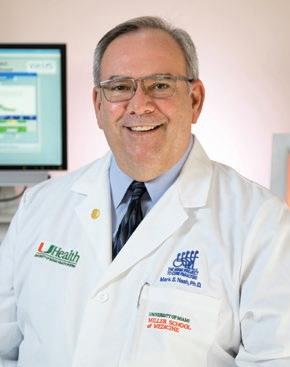
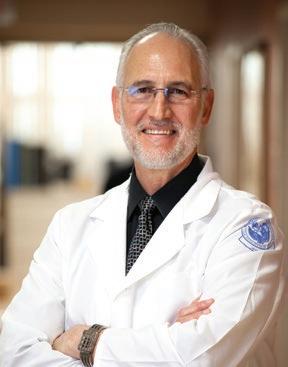
Clinical Associate Professor, Departments of Neurology, Neurological Surgery, and Orthopedics and Rehabilitation Medicine
Pathophysiology and Treatment of Secondary Complications in Spinal Cord Injury
My research interests focus on common complications that are seen following spinal cord injury: pain, spasticity, syringomyelia, and tethered cord syndrome. My interests include investigating the basis for the development of the different spasticity and pain profiles in the spinal cord injured population and to study potential novel treatments for those conditions.
DAVID W. MCMILLAN, PH.D.
Director of Education and Outreach, The Miami Project
Research Assistant Professor, Department of Neurological Surgery
My dissertation pertained to the role of the autonomic nervous system in the absorption, trafficking, and fates of dietary fat. I am now refocusing my efforts to align with local opportunities seen from my Outreach role—aiming at the disproportionate risks and rewards posed by the Tropical Atlantic on people living with SCI (PwSCI). Regarding risks, I study the vulnerabilities of PwSCI to climate hazards in the form of flooding, heat, and hurricanes. Regarding rewards, I study the transformative potential that adapted ocean activities—such as sailing, scuba diving, swimming, and others—carries for adults with physical disability.
MARK S. NASH, PH.D., F.A.C.S.M.
Associate Scientific Director for Research, The Miami Project to Cure Paralysis
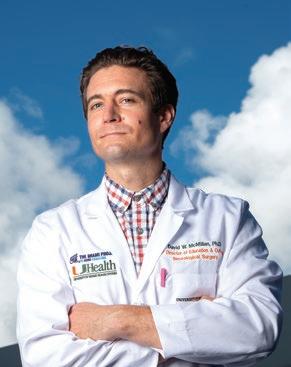
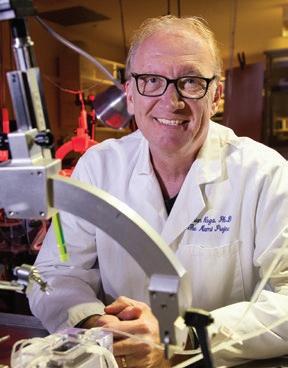
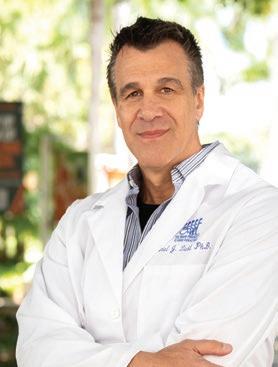
Professor, Departments of Neurological Surgery, Physical Medicine & Rehabilitation, Physical Therapy, and Kinesiology & Sports Sciences
Physiological Assessment of Secondary Complications following SCI: Electrical Stimulation, Cardiometabolic and Vascular Physiology, Cardioendocrine Pathology and Intervention, and Exercise and Nutritional Biochemistry
One of the enduring goals of The Miami Project has been to test and then translate strategies that optimize health of persons with SCI. A significant target for this strategy has focused on physical activity to lessen secondary risks of SCI associated with physical deconditioning. We also examine complementary themes to optimize exercise prescription after SCI, identify optimal nutritional intake, and use prescription and non-prescription agents that reduce hazards of fasting and postprandial lipid disorders, dysglycemia, and vascular inflammatory stress.
BRIAN R. NOGA, PH.D.
Research Associate Professor, Department of Neurological Surgery
Brain and Spinal Mechanisms Controlling Walking
Neuromodulation technologies are increasingly looked at as potential treatment options for paralysis associated with spinal cord injury (SCI). Deep brain stimulation is one such method that so far has had little or no application in persons with SCI even though most new and chronic injuries are incomplete. Recent work in our laboratory has pointed to a brain target for controlling walking. We are currently investigating the usefulness of stimulating this site to enhance walking in a translational large animal model of SCI.
KEVIN K. PARK, PH.D.
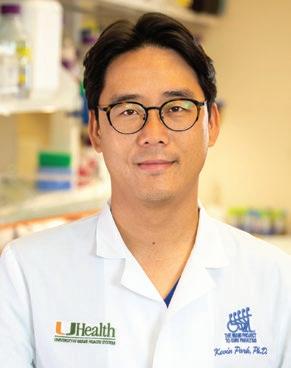
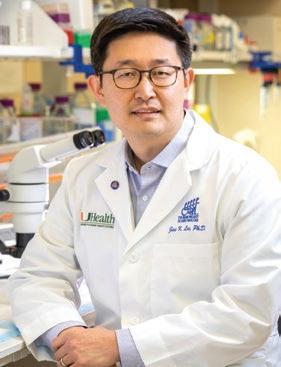
Associate Professor, Department of Neurological Surgery
Promoting Neural Regeneration and Survival
My lab is interested in understanding mechanisms that account for axon growth, guidance and circuit formation in the central nervous system (CNS). Previously, I and others have identified several key proteins that regulate axon regeneration, which are present in mature CNS neurons. In my current research, I seek to better understand the cellular and molecular mechanisms governing axon growth and connectivity during development and in adults after injury, and to explore the potential of developing therapeutic strategies for spinal cord injury and other neurodegenerative conditions.
DAMIEN D. PEARSE, PH.D.
John M. and Jocelyn H.K. Watkins Distinguished Chair in Cell Therapies
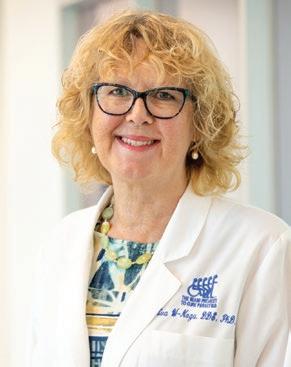
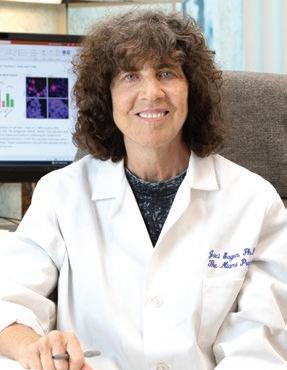
Professor, Department of Neurological Surgery, Health Scientist Veterans Affairs
Exploration and Translation of Therapeutic Strategies to Repair the Injured Spinal Cord and Brain
My laboratory focuses on several key aspects of CNS injury repair, including (1) the utility and clinical translation of exogenous and endogenously harnessed cell therapeutics (particularly when used in combinatory approaches), (2) understanding the role of, and developing therapies for, altered cyclic AMP (adenylyl cyclase, phosphodiesterases, and PKA) and MAPK signaling in neurons and glia after CNS injury, (3) the use of nanotherapeutics for multifunctional and site-directed gene/drug targeting to the injured CNS, and (4) the application of methodologies for improved imaging of axonal regeneration and cell integration within the injured CNS such as 3D ultramicroscopy and diffusion tensor imaging.
ABHISHEK PRASAD, PH.D.
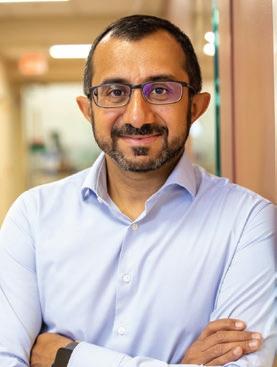
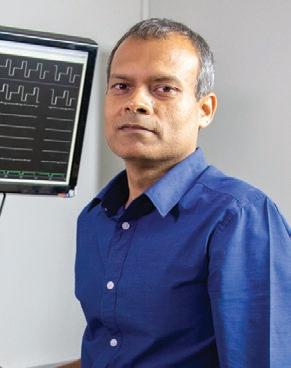
Associate Professor of Biomedical Engineering
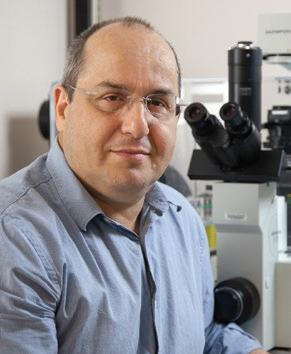
Our lab is investigating better and alternate materials for electrodes and insulation that will minimize the corrosion and delamination problem. To mitigate the foreign body response due to implanted materials, we are using therapeutic and pharmacological approaches to reduce the neuroinflammation and oxidative stress that occurs after an electrode implant.
SUHRUD M. RAJGURU, PH.D.
Co-Director, Institute for Neural Engineering
Associate Professor, Biomedical Engineering & Otolaryngology
Assistant Director, University of Miami CTSI Team Science
My laboratory and collaborators (W. Dalton Dietrich and Michael Hoffer) at the University of Miami have been at the forefront of using therapeutic hypothermia applied locally to the inner ear to benefit patients undergoing cochlear implantation. Now we have expanded its application using a custom-designed device and a unique non-invasive approach to noise-induced hearing loss. Our work on therapeutic hypothermia has been published in multiple peer-reviewed studies and presented at national and international conferences.
JACQUELINE SAGEN, PH.D., M.B.A.
Professor, Department of Neurological Surgery
Cellular Implants and Gene Therapy for the Alleviation of Chronic Pain and CNS Injury
Our laboratory is exploring novel and more effective strategies in the therapeutic management of chronic debilitating pain. Our recent research is focused on (1) identification of more effective analgesic agents and combinations for alleviating pain using SCI and peripheral neuropathic pain models and (2) development of emerging therapeutic interventions, including cell transplantation and gene therapy, which have the potential to provide long-term alleviation in people with intractable pain, overcoming the need for repeated pharmacologic administration.
PANTELIS TSOULFAS,
M.D.
Associate Professor, Departments of Neurological Surgery and Cell Biology & Anatomy
Neurotrophins: Specificity of Action
My laboratory is interested in two areas of neurobiology that are significant for developing new strategies for spinal cord injury repair. Over the past years, we have worked to modify neurotrophins that are better suited for use in SCI. We are also interested in understanding the processes involved in maintaining and differentiating neural stem cells.
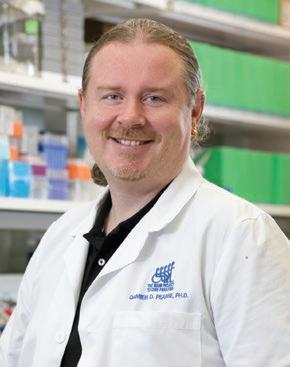
MICHAEL Y. WANG, M.D., F.A.C.S.
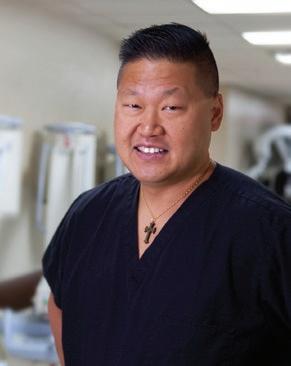
Professor, Departments of Neurological Surgery and Physical Medicine & Rehabilitation
Director of Neurosurgery, University of Miami Hospital
Spinal Cord Injury Outcomes
My primary research has been in the investigation of SCI Outcomes. I work with Miami Project researchers Drs. Allan Levi and Barth Green in studying the clinical effects of Hypothermia. Currently, a multi-center randomized, prospective study on the effects of hypothermia in SCI is underway. In addition, I am studying the clinical application of SCI biomarkers to predict the effects of both injuries as well as therapeutic interventions with Drs. Dalton Dietrich and Ross Bullock.
EVA WIDERSTRÖM-NOGA, D.D.S., PH.D.
Research Professor, The Miami Project to Cure Paralysis, the Departments of Neurological Surgery and Physical Medicine & Rehabilitation
Interdisciplinary Research Approaches to Improve Neuropathic Pain Management after Neurotrauma
My research program is interdisciplinary and includes the identification of clinical correlates of underlying mechanisms of neuropathic pain associated with neurological trauma as a way to facilitate the translation of basic research findings to treatments tailored to specific mechanisms. A recent line of research in my program aims to better understand cortical mechanisms of multisensory integration and how to manipulate these mechanisms by visual illusion and transcranial electrical stimulation to reduce pain. In addition, we have examined SCI stakeholders (people with SCI and neuropathic pain, their significant others and SCI healthcare providers) perspectives on barriers and facilitators to optimal management of neuropathic pain. Based on this work we have developed a preliminary pain education tool that is now further refined based on structured stakeholder feedback. My research program is highly collaborative and includes extensive interdisciplinary protocols for a multimodal evaluation of self-reported pain symptoms and its psychosocial impact, quantitative assessment of neurological function, and biomarkers including non-invasive brain imaging and electrophysiology.








